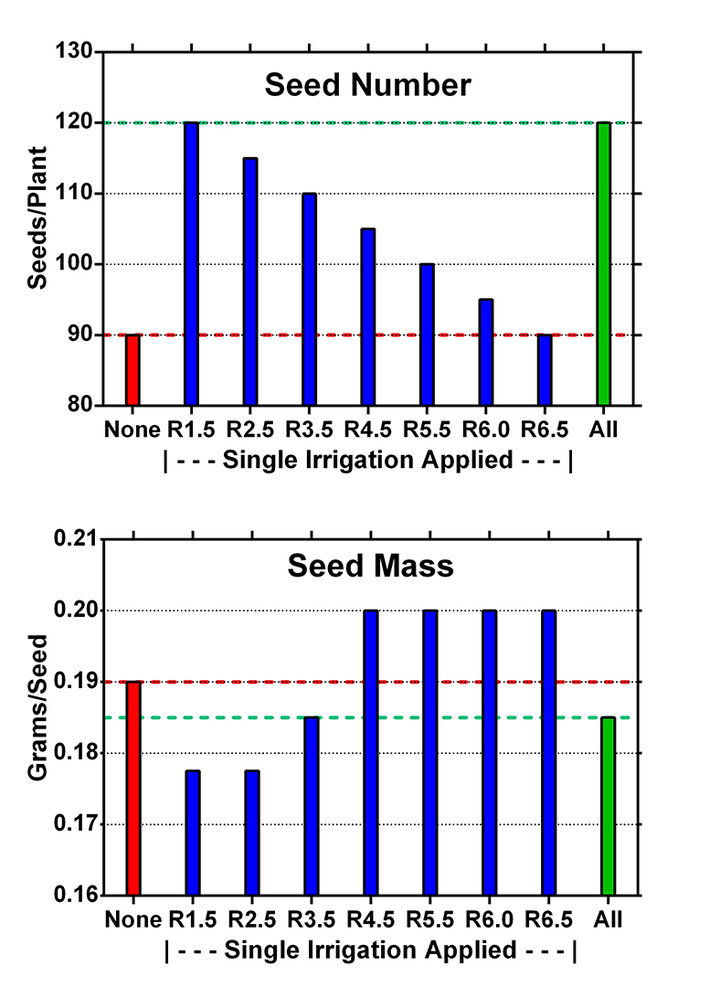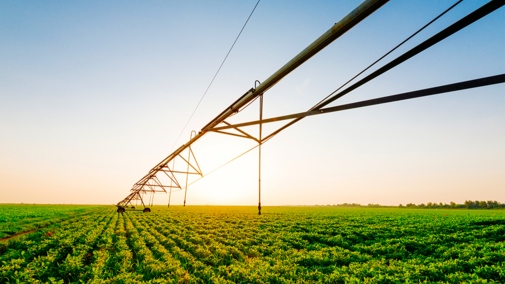During soybean reproductive development, three stages — R1-R2 (flowering), R3-R4 (podding), and R5-R6 (seed-filling) — occur successively during July and August in the growing season. Soybean yield is ultimately a function of just two components, the harvested seed number (in terms of unit land area), and the seed mass (weight of the average harvested seed). It is known that seed number is set during the R1 to R4 stages of flowering and podding, though abortion of pods or seeds in those pods can occur in the later R stages. Conversely, seed mass (i.e., size) is set during the R5 to R6 stages of seed-filling, as the seeds undergo enlargement until the R6 stage ends at the onset of the R7 (physiological maturity) stage.
In a companion CropWatch article, readers were provided details on how to use a post-harvest protocol to conveniently measure — while in a soybean field or later — the seed mass yield component. That value, when coupled with the seed yield value, can be used to derive a value for corresponding seed number yield component.
To determine the drought-stress sensitivity of each of these two key yield components during the foregoing R stages, a replicated three-year experiment involving 14 MG 0 to IV soybean varieties was conducted, using seven treatments — each consisting of a single irrigation application, but each treatment differed with respect to the R stage coinciding with the single irrigation event. Two other treatments involved a rainfed control (i.e., no irrigation applied), plus a multiple-irrigation control (i.e., seven total irrigations were applied that had the same R-stage timing as the single irrigation treatments). The study results were reported in the two Agronomy Journal papers published by Kadhem et al. (1985a; 1985b).
In this article, we summarize the results obtained in the foregoing experiment to show the impact of R stage-timed single irrigation events that temporarily mitigated water stress during that R-stage. This permitted the study authors to measure the impact of stress mitigation on each yield component. Those experimental results are conceptually interpolated here to provide a contextual framework to help producers recognize and understand the value of using foregoing post-harvest measurement protocol to evaluate the impact of seasonal weather patterns on their rainfed soybean yields and the two yield components.
Figure 1 displays a conceptualized re-drawing of the top two charts presented in Figure 3 of the Kadhem et al. (1985b) paper. The upper panel shows the seed number data (in units of average seeds/plant), and lower panel shows the seed mass data (in units of average grams/seed) on their two respective vertical Y-axes. The horizontal X-axis in both panels displays nine bars, the first bar depicting the control (no irrigation — rainfed only), the next seven successive bars depicting the single irrigation treatments — each of which coincided with the specified Rn.n stage — and then the final bar depicting the multiple irrigation treatment that precluded all seasonal water stress.

To best comprehend what is presented in Figure 1, the reader should first focus on the seed number and seed mass response patterns generated by the blue bar single irrigation treatments. Note that a single irrigation applied during the flowering stage (first two blue bars) resulted in a substantial increase in seed number, but also generated a lower seed mass relative to the control rainfed treatment. This indicated that when water stress is mitigated during flowering (but not thereafter), soybean plants will be conditioned to set more seeds, but also end up making those seeds smaller when water is not adequate thereafter.
In contrast, when a single irrigation is applied during the seed-filling stage (last three blue bars), fewer seeds are set (and/or retained) due to prior water stress, but the mass of those fewer seeds is optimized due to the late-applied single irrigations that mitigate any coincident water stress.
What is also worthy of noting is that delaying the timing of a single irrigation event from R1 to late R6 resulted in a progressive linear decline in the number of seed set (and/or retained), as can be seen when viewing all seven blue bars in the top seed number panel. However, in the seed mass panel, delaying the timing of the single irrigation events generated a lazy S-shaped response pattern with a breakpoint occurring between the single irrigation events coinciding with R3.5 and R4.5 (third and fourth blue bars). This response pattern indicates that when soybean plants are in the podding stage, those plants are conditioned to enhance seed mass while still increasing seed number to some degree.
Seed yield (not shown here — see Figure 3c in Kadhem et al., 1985b) is a biophysical function of both yield components, so not surprisingly, these R3.5- and R4.5-timed single irrigation applications generated the highest seed yields amongst all nine treatments. Indeed, this is why if you can only apply just one irrigation to your soybean field, it is recommended that it be applied during the R3-R4 podding stage (Torrion et al. 2014).
Note that the full-season multiple irrigation treatment (green bar) resulted in a maximization of seed number, but seed mass was not increased beyond the increase achieved with single irrigation at R3.5. Thus, in the absence of any seasonal water stress, seed number (which is set before seed mass) is prioritized by stress-free plants relative to optimization.
Note that the experimental results described here were obtained in a study conducted 40 years ago using just the then-available publicly developed soybean varieties. Currently available proprietary and public varieties possess much greater yield potential, and if used in a study like this one, could respond differently (or similarly). In the meantime, the older study still provides a useful baseline perspective for readers until newer experiments are conducted.
References
Kadhem, F.A., J. E. Specht, and J. H. Williams. 1985a. Soybean Irrigation Serially Timed During Stages R1 to R6. I. Agronomic responses. Agron. J. 77:291-298. https://doi.org/10.2134/agronj1985.00021962007700020026x
Kadhem, F.A., J. E. Specht, and J. H. Williams. 1985b. Soybean Irrigation Serially Timed During Stages R1 to R6. II. Yield Component Responses. Agron. J. 77:299-304. https://doi.org/10.2134/agronj1985.00021962007700020027x
Torrion, J.A., T.D. Setiyono, G.L. Graef, K.G. Cassman, S. Irmak, and J. E. Specht. 2014. Soybean irrigation management: Agronomic impacts of deferred, deficit, and full-season strategies. Crop Sci. 54:2782-2795. https://doi.org/10.2135/cropsci2014.03.0261

